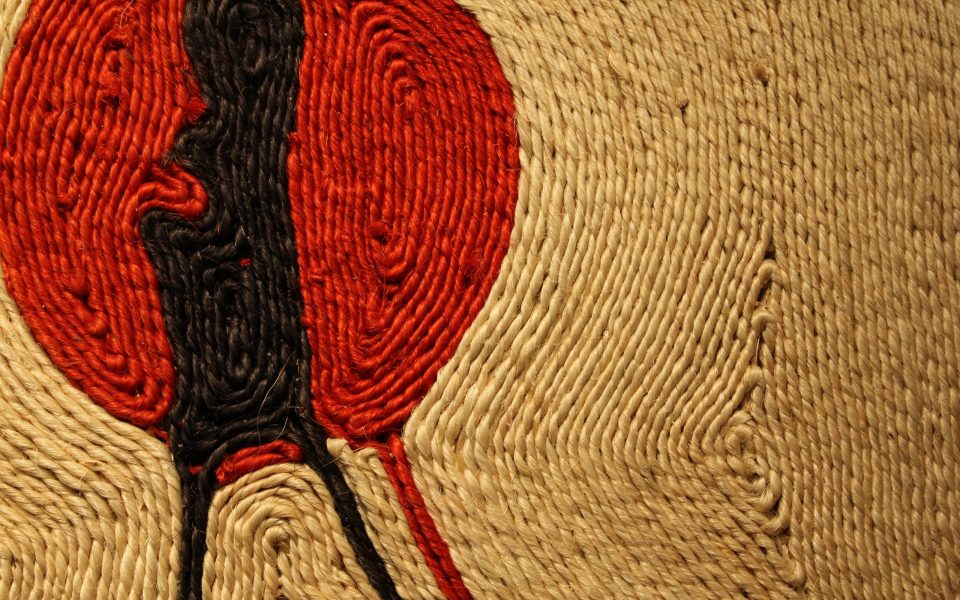Handwoven maguey fibers give the tapestries a nice texture. (courtesy image)
by Daniel Wirtheim
Roymieco Carter first saw the tapestries when he opened the NC A&T University gallery’s vault five years ago, after becoming the university’s director of the visual arts program. At first he thought they might be African until he saw the signature woven into the bottom of all 14: Calder.
Alexander Calder was well known for his mobiles, sculptures of delicately balanced, hanging components — some even call him the originator of the mobile. Calder was posthumously awarded the Presidential Medal of Freedom for his legacy of enormous mobile structures that were commissioned around the world.
Through his research, Roymieco Carter learned that Calder gave the designs to a group of Guatemalan and Nicaraguan weavers after an earthquake devastated Nicaragua. That was in 1972, when Calder’s name was already well known and his works sold for large sums at auction. Since anything with his signature could sell for thousands, Calder’s gift was an economic stimulus package to the people of Guatemala and Nicaragua.
French weavers had already been making Calder’s designs into tapestries when Bon Art, the group of Guatemalan women who sewed the tapestries at A&T, made their own edition. The French tapestries, called “Aubussons” after the village from where the weavers originated, use very fine wool and a hand-sewn technique that give the tapestries a pristine look. But it’s the rugged, earthy texture of the Bon Art tapestries that make them so appealing.
They’re woven from maguey fiber, a durable and ropey material found in arid climates like Guatemala. Calder’s designs make use of the maguey’s natural beige color as a background for primary colors. This is unlike the Aubussons, which occasionally use white as a background. The designs are, for the most part, painted in the primary colors of red, blue and yellow. Carter said the shapes are pulled from nature, some of them identifiable as zebra stripes, mountains and a boomerang.
The fibers are woven together in bunches that radiate around the shapes and often run into the path of another to resemble complex circuitry. For this reason the tapestries are best seen up close and in person. The complex movement of the hand-woven fiber is what makes the Bon Art editions so intriguing compared to their earlier French counterparts.
There is a copyright mark woven into each of the tapestry’s top left corner, seeming to wink at the immense amount of money that goes to the art trade. Carter estimates that some of the tapestries cost close to $8,000. It’s a lot but not comparable to the Aubussons, which sell for as much as $54,000. But to Carter, the tapestries are less about the money and more about story of Guatemala.
Carter says that the tapestries express a folk tradition of the Guatemalan people that he thinks is important to share with the public.
“For the 17 Days festival, everyone dug deep to find what treasures they could share with the community,“ Carter said, “and these are what we pulled out of the vault.”
While the Bon Art editions are praised for their adaptation of one of the world’s most notable artists, some of the fiber tapestries have been suspect to scrutiny.
The Calder Foundation website indicates some of the tapestries made as a part of the charitable effort are illegitimate, that while Calder authorized the use of a select number of pre-existing designs, he never authorized numbered editions of his works. It goes on to explain that many of the maguey fiber tapestries bear false edition numbers. But so far, no lawsuit has been filed and the Bon Art edition still stands as a valuable and exciting Calder interpretation.
“One will be my favorite and then I’ll come in again and see something in another one,” Carter said. “‘Swirl’ was my first favorite and then I came in again and thought, ‘Well, ‘Turquoise’ kind of stands on its own.’ There’s a lot to take in.”
Join the First Amendment Society, a membership that goes directly to funding TCB‘s newsroom.
We believe that reporting can save the world.
The TCB First Amendment Society recognizes the vital role of a free, unfettered press with a bundling of local experiences designed to build community, and unique engagements with our newsroom that will help you understand, and shape, local journalism’s critical role in uplifting the people in our cities.
All revenue goes directly into the newsroom as reporters’ salaries and freelance commissions.


Very beautiful, but they are hand-sewn, not woven. The definition of tapestry has grown to include just about any kind of pictorial fabric, but traditional tapestry is defined by dictionary.com as “a fabric consisting of a warp upon which colored threads are woven by hand to produce a design, often pictorial, used for wall hangings, furniture coverings, etc.” Tapestry weavers define tapestry as hand-woven with a discontinuous weft. Aubusson tapestries are hand woven on a low warp loom. The embroidered but misidentified Bayeux Tapestry has contributed to the popular definition of tapestry being expanded to include other methods of art cloth. You can call these Guatemalan art cloths tapestries, but they are not woven. Last year, 17 Days hosted a fiber exhibit of crocheted pieces and called them tapestries. I went to the exhibit, and technically, they were not tapestries either. Sincerely, your friendly fiber art educator and local tapestry weaver, Laurie